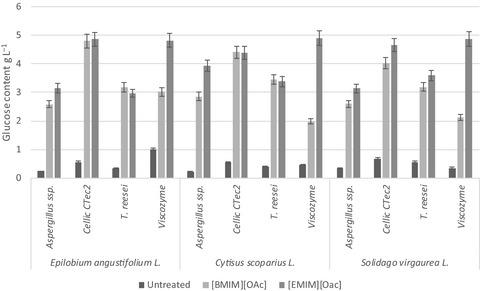当前位置:
X-MOL 学术
›
Energy Sci. Eng.
›
论文详情
Our official English website, www.x-mol.net, welcomes your feedback! (Note: you will need to create a separate account there.)
Evaluation of the potential of fireweed (Epilobium angustifolium L.), European goldenrod (Solidago virgaurea L.), and common broom (Cytisus scoparius L.) stems in bioethanol production
Energy Science & Engineering ( IF 3.8 ) Pub Date : 2020-05-15 , DOI: 10.1002/ese3.726 Małgorzata Smuga‐Kogut 1 , Daria Szymanowska 2 , Roksana Markiewicz 3 , Tomasz Piskier 1 , Joanna Kobus‐Cisowska 4 , Judyta Cielecka‐Piontek 5 , Heralt Schöne 6
Energy Science & Engineering ( IF 3.8 ) Pub Date : 2020-05-15 , DOI: 10.1002/ese3.726 Małgorzata Smuga‐Kogut 1 , Daria Szymanowska 2 , Roksana Markiewicz 3 , Tomasz Piskier 1 , Joanna Kobus‐Cisowska 4 , Judyta Cielecka‐Piontek 5 , Heralt Schöne 6
Affiliation

|
One of the main goals of industrial biotechnology is to develop an effective method for ethanol production for fuel purposes using lignocellulosic biomass. Variability of lignocellulosic raw materials, selection of an effective method for the pretreatment of raw material, and selection of microorganisms with the ability to ferment not only hexoses but also pentoses and are moreover resistant to environmental stress generated by the products of lignocellulosic complex decomposition, are the challenges encountered in ethanol production. The use of agricultural wastelands and overgrowing plants that have little possibility of application in processes other than energy production seem to be an interesting alternative to conventional, but very often rather cultivation demanding energy crops. The aim of this study was to evaluate the possibility of using the stems of fireweed (Epilobium angustifolium L.), European goldenrod (Solidago virgaurea L.), and common broom (Cytisus scoparius L.) for ethanol production. The key elements studied were characteristics of the lignocellulosic complex structure, influence of the selected ionic liquids on the structural changes in biomass, and efficiency of enzymatic hydrolysis and ethanol fermentation processes. The results showed that under the assumed conditions the best effect was observed with the fireweed materials subjected to pretreatment with 1‐ethyl‐3‐methylimidazolium acetate and enzymatic hydrolysis with Viscozyme® preparation. The final concentration of ethanol obtained was 2.509 g L−1 with a yield of 92.3%. This was due to the highest share of cellulose (40.9%) in the whole lignocellulosic complex compared to other raw materials, which in combination with the selection of an appropriate ionic liquid and an enzymatic preparation, led to high bioprocess efficiency.
中文翻译:

杂草(Epilobium angustifolium L.),欧洲菊科(Solidago virgaurea L.)和普通扫帚(Cytisus scoparius L.)的潜力在生物乙醇生产中的评估
工业生物技术的主要目标之一是开发一种利用木质纤维素生物质为燃料生产乙醇的有效方法。木质纤维素原料的多样性,选择一种有效的原料预处理方法以及选择具有不仅能够发酵己糖而且还可以发酵戊糖并且能够抵抗木质纤维素复合物分解产物所产生的环境压力的微生物的选择。乙醇生产中遇到的挑战。在能源生产以外的过程中使用农业废地和生长过度的植物几乎没有用处,这似乎是传统方法的一种有趣替代方法,但通常需要大量种植能源作物。Epilobium angustifolium L.),欧洲菊科植物(Solidago virgaurea L.)和普通扫帚(Cytisus scoparius L.)用于生产乙醇。研究的关键要素是木质纤维素复合结构的特征,所选离子液体对生物量结构变化的影响以及酶水解和乙醇发酵过程的效率。结果表明,在假定的条件下,杂草材料用1-乙基-3-甲基咪唑鎓乙酸盐预处理并用Viscozyme®制剂进行酶水解可观察到最佳效果。最终获得的乙醇浓度为2.509 g L -1收率为92.3%。这是由于与其他原料相比,纤维素在整个木质纤维素复合物中的比例最高(40.9%),再加上选择合适的离子液体和酶制剂,可提高生物处理效率。
更新日期:2020-05-15
中文翻译:

杂草(Epilobium angustifolium L.),欧洲菊科(Solidago virgaurea L.)和普通扫帚(Cytisus scoparius L.)的潜力在生物乙醇生产中的评估
工业生物技术的主要目标之一是开发一种利用木质纤维素生物质为燃料生产乙醇的有效方法。木质纤维素原料的多样性,选择一种有效的原料预处理方法以及选择具有不仅能够发酵己糖而且还可以发酵戊糖并且能够抵抗木质纤维素复合物分解产物所产生的环境压力的微生物的选择。乙醇生产中遇到的挑战。在能源生产以外的过程中使用农业废地和生长过度的植物几乎没有用处,这似乎是传统方法的一种有趣替代方法,但通常需要大量种植能源作物。Epilobium angustifolium L.),欧洲菊科植物(Solidago virgaurea L.)和普通扫帚(Cytisus scoparius L.)用于生产乙醇。研究的关键要素是木质纤维素复合结构的特征,所选离子液体对生物量结构变化的影响以及酶水解和乙醇发酵过程的效率。结果表明,在假定的条件下,杂草材料用1-乙基-3-甲基咪唑鎓乙酸盐预处理并用Viscozyme®制剂进行酶水解可观察到最佳效果。最终获得的乙醇浓度为2.509 g L -1收率为92.3%。这是由于与其他原料相比,纤维素在整个木质纤维素复合物中的比例最高(40.9%),再加上选择合适的离子液体和酶制剂,可提高生物处理效率。



























 京公网安备 11010802027423号
京公网安备 11010802027423号